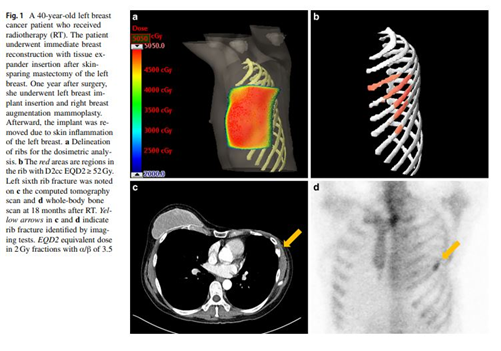글로벌 연구동향
방사선종양학
- 2023년 03월호
[Strahlenther Onkol .] Near-maximum rib dose is the most relevant risk factor for ipsilateral spontaneous rib fracture: a dosimetric analysis of breast cancer patients after radiotherapy서울의대 / 김도욱, 신경환*
- 출처
- Strahlenther Onkol .
- 등재일
- 2023 Jan
- 저널이슈번호
- 199(1):38-47. doi: 10.1007/s00066-022-01972-9.
- 내용
Abstract
Purpose: Spontaneous rib fracture (SRF) is a common late complication in treated breast cancer patients. This study evaluated the incidence and risk factors of ipsilateral SRF after radiotherapy (RT) in breast cancer patients. In addition, we identified dosimetric parameters that were significantly associated with ipsilateral SRF.Methods: We retrospectively reviewed 2204 patients with breast cancer who underwent RT between 2014 and 2016, and were followed up with bone scans. We evaluated clinical risk factors for ipsilateral SRF. Dose-volume histogram analysis was also performed for patients (n = 538) whose dosimetric data were available. All ipsilateral ribs were manually delineated, and dosimetric parameters of the ribs were converted into the equivalent dose in 2 Gy fractions (EQD2).
Results: Most of the patients with SRF (87.3%) were asymptomatic, and the remaining symptomatic patients complained of mild tenderness or chest wall discomfort; these symptoms all resolved within 6 months without any treatment. Ipsilateral SRF occurred in 14.5% of patients 3 years after RT. The median time to develop ipsilateral SRF was 15 months. In dosimetric analysis, near-maximum rib dose (D2cc) best predicted ipsilateral SRF. The cut-off value of D2cc was EQD2 52 Gy, as determined by receiver operating characteristic analysis. In multivariate analysis including dosimetric variables, D2cc EQD2 ≥ 52 Gy was the only significant risk factor for ipsilateral SRF.
Conclusion: Our data demonstrated that near-maximum rib dose was the best dosimetric parameter to predict ipsilateral SRF in RT-treated breast cancer patients. In addition, our results suggest that patients who received RT with exceeding rib dose cut-off value and had ipsilateral SRF on bone scan be recommended routine follow-up without additional imaging tests.

Affiliations
Dowook Kim 1, Kyubo Kim 2, Jae Sik Kim 1 3, Seonghee Kang 4 5, Jong Min Park 1 4 5, Kyung Hwan Shin 6 7 8
1Department of Radiation Oncology, Seoul National University College of Medicine, Seoul, Korea (Republic of).
2Department of Radiation Oncology, Ewha Womans University College of Medicine, Seoul, Korea (Republic of).
3Department of Radiation Oncology, Kyung Hee University Hospital at Gangdong, Seoul, Korea (Republic of).
4Department of Radiation Oncology, Seoul National University Hospital, Seoul, Korea (Republic of).
5Institute of Radiation Medicine, Seoul National University Medical Research Center, Seoul, Korea (Republic of).
6Department of Radiation Oncology, Seoul National University College of Medicine, Seoul, Korea (Republic of). radiat@snu.ac.kr.
7Department of Radiation Oncology, Seoul National University Hospital, Seoul, Korea (Republic of). radiat@snu.ac.kr.
8Institute of Radiation Medicine, Seoul National University Medical Research Center, Seoul, Korea (Republic of). radiat@snu.ac.kr.
- 키워드
- Adverse effect; Breast neoplasm; Maximum tolerated doses; Radiation-induced rib fracture; Radiotherapy.
- 덧글달기
- 이전글 [Cancer Res Treat .] Suggestions for Escaping the Dark Ages for Pediatric Diffuse Intrinsic Pontine Glioma Treated with Radiotherapy: Analysis of Prognostic Factors from the National Multicenter Study
- 다음글 [Jpn J Clin Oncol .] Patterns of regional recurrence according to molecular subtype in patients with pN2 breast cancer treated with limited field regional irradiation








편집위원
유방암 방사선치료 후 늑골골절의 위험도를 선량학적으로 분석한 논문
덧글달기닫기2023-03-07 08:55:36
등록